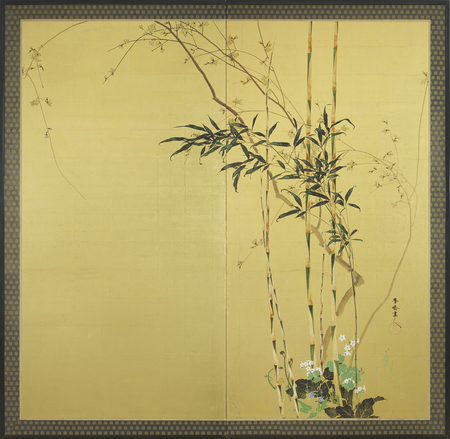Product Description
7342 A two-fold screen painted in ink and colour on a gold ground with bamboo trees and sakura (cherry tree) blossoms
Signed: Kōkyō with seal
Japan 20th century Meiji period
Dimensions: H. 68¾” x W. 71″ (174.5cm x 180cm)
Taniguchi Kōkyō (1864-1915) Given name: Tsuchinosuke. Gō (art name): Kōkyō.
Kōkyō was born in Hinonemura (present day Izumisano), Osaka Prefecture the second son of a cloth merchant Tsuji Kyūjiro (dates unknown) but was later adopted by the Taniguchi family. In 1884 he started studying painting under Kōno Bairei (1844-1895) and in 1888 he assisted in the publication of Bijyutsusōshi (Arts Magazine). Kokyō is considered one of the founders of the modern Kyoto school and one of the four masters of nihonga (Japanese style) together with Kukuchi Hōbun (1861-1918), Takeuchi Seihō (1864-1942) and Tsuji Kakō (1870-1931).
In 1895 his piece entitled Nengemishō (Flower Sermon) won the third prize at the 4th Naikoku Kangyō Hakurankai (National Industrial Exhibition). In 1900 his piece entitled Shū (Rain Shower) won the bronze medal at the Paris International Exhibition and in 1902 he visited the Turin International Fair. In 1907, at the 1st Bunten (Fine Arts Exhibition of the Ministry of Culture) Kokyō’s painting entitled Yamauba (Mountain Old Lady Ghost) received the third prize and he later served as a judge for the 4th and 5th Bunten in 1910 and 1912 respectively. His acclaimed historical paintings Kokyō taught at Kyoto City University of Arts between 1909 and 1912. He was famous for his landscapes, kachoga (birds and flower painting) and historical subjects which were based on his deep and thorough knowledge of Chinese history.
Works by the artist can be found in the collections of: Staatliche Museen Berlin, Ostasiatische Kunstabteilung; Victoria & Albert Museum, London; Art Institute, Chicago








